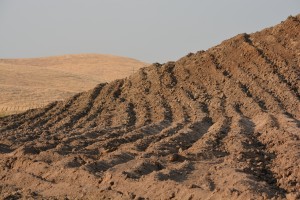
When advocates for farmland preservation argue that urban sprawl is destroying prime farmland, their critics have a ready response:
“Now that we can rip soil and grow crops anywhere, what’s the need to preserve farmland around cities?”
Developers and their allies also cite impressive increases in acreage for irrigated farmland, and they’re right. In Stanislaus County alone, tens of thousands of acres of irrigated farmland have been added in just a few years, mostly in the eastern foothills.
Formerly arid rangeland, the foothills have become a verdant monoculture, with almond orchards extending mile after mile in all directions. The windmills, cattle, and soaring raptors that once typified the region have given way to an ever-expanding forest of green.
Ordinarily brown and sere, foothills soil has been transformed. When leveled and ripped, it stands up like sifted flour. Dark, fragrant, and velvety, it begs to be planted.
“All it needs is water,” say the farmers. It’s a familiar refrain in the arid San Joaquin Valley, and expresses a longing that time and again has proven fatal to the public interest.
That foothills soil is much like the soil in the southwestern San Joaquin Valley, where farmers have long boasted they can grow anything. “All we need is water,” they say.
And over the years, through political machinations and ever more complex water projects, they’ve gotten water. The outcome has been a prodigious growth in agriculture.
But even fertile soil and miraculous manipulations of water haven’t been able to evade the laws of nature. The truth is that even though there’s lots of arable land, there are only a few places where faming is sustainable and even fewer where the intense irrigation required by nut trees doesn’t poison the soil.
Combined with poor drainage, the miracle of drip irrigation is a classic case of unintended consequences. It facilitates concentrations of salt in the soil and ultimately makes farming of any crop impossible. With nut trees that need three feet of water a year, the process is accelerated.
And that’s what’s happened in the southwestern portions of the San Joaquin Valley. Ever more water is needed to flush the soils. Today, those who can get that water are paying between $800 and $1100 an acre foot.
But even prodigious applications of water can’t save soil that’s accumulated too much salt. Much is said about farmers having to fallow land during the current drought, but the truth is much of the fallowed land can no longer be farmed.
In fact, land idling is now the biggest factor in those places with irrigated land decreases. “Land idling was especially acute on the west side of the San Joaquin Valley, where there are issues with the ongoing drought and increased soil salinity,” said Molly Penberth of the Farmland Mapping and Monitoring Program on June 25.
But why worry about water and salinity when there’s good soil and groundwater in the foothills? Early comers who planted trees in the southwestern portions of the Valley made fortunes before ruining the land, and there are still plenty of opportunities for shrewd investors to cash in on groundwater before the aquifer runs dry.
That’s why even during an epic drought the foothills of eastern Stanislaus and Merced Counties continue to roar with action from tractors and dozers, grading and ripping from dawn to dusk.
It’s also why developers and their allies are rubbing their hands in glee at the prospect of covering some of the last of the truly good soil on the Valley floor—the stuff that’s not only fertile but flood-irrigated and capable of recharging an aquifer that enables generation after generation of sustainable agriculture.
“You can rip soil and grow crops anywhere,” they say, and corporate farmers are only too willing to agree.
“You’re right,” they say. “All we need is water.”

The term “sustainable” is usually omitted from the dialogue of developers. The quick buck is usually given priority over wise long term use of the land. Future generations will be the ones to suffer most from the short sighted decisions.